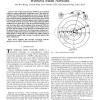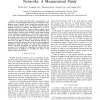491 search results - page 4 / 99 » Optimal physical carrier sense in wireless networks |
CORR
2007
Springer
13 years 9 months ago
2007
Springer
— The fairness of IEEE 802.11 wireless networks (including Wireless LAN and Ad-hoc networks) is hard to predict and control because of the randomness and complexity of the MAC co...
MOBIHOC
2008
ACM
14 years 9 months ago
2008
ACM
Dealing with interference is one of the primary challenges to solve in the design of protocols for wireless ad-hoc networks. Most of the work in the literature assumes localized o...
JSAC
2006
13 years 9 months ago
2006
The wireless mesh network (WMN) is an economical solution to support ubiquitous broadband services. This paper investigates the tradeoffs among quality-of-service (QoS), capacity, ...
CN
2008
13 years 10 months ago
2008
In high density (HD) IEEE 802.11 WLAN, packet loss can occur due to co-channel interference (asynchronous interference) or collisions (synchronous interference). In order to effec...
ICC
2007
IEEE
14 years 4 months ago
2007
IEEE
—In wireless networks where communications are made over a shared medium, interference and collisions are the primary causes of packet drops. In multi-hop networks such as wirele...


